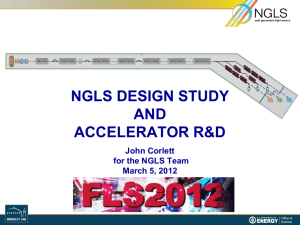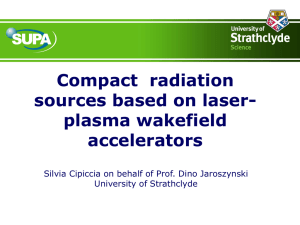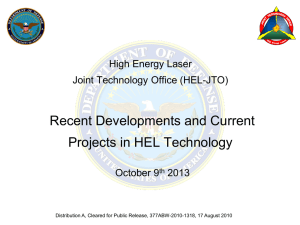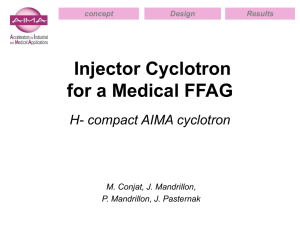High-harmonic generation off a spooling tape as seed for the laser
advertisement
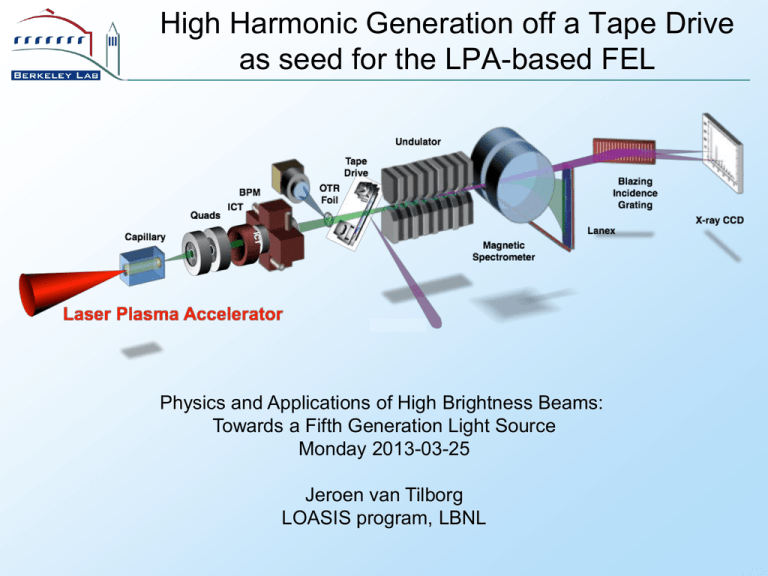
High Harmonic Generation off a Tape Drive as seed for the LPA-based FEL Physics and Applications of High Brightness Beams: Towards a Fifth Generation Light Source Monday 2013-03-25 Jeroen van Tilborg LOASIS program, LBNL Acknowledgements HHG experiments: Brian Shaw, Thomas Sokollik, Jeroen van Tilborg, and Wim Leemans FEL concept & simulations: Carl Schroeder Other LOASIS contributors: Sergey Rykovanov, Anthony Gonsalves, Kei Nakamura, Sven Steiniger, Nicholas Matlis, Eric Esarey, Csaba Tóth, Carlo Benedetti, and Cameron Geddes Collaborators CEA Saclay: LBNL, ALS: LBNL, Metrology: LDRD Sylvain Monchocé, Fabien Quéré, Arnaud Malvache, and Philip Martin Eric Gullikson Valeriy Yashchuk, Wayne McKinney, and Nikolay Artemiev Outline Efforts at LOASIS/Bella Introduction to Coherent Wake Emission Experimental setup and data Influence of tape and laser parameters FEL calculations Comparison CWE details to model Each LOASIS/Bella system addresses unique challenges Godzilla Matlis, 10:50am TREX Bella High-quality LPA e-beams: compact coherent light source [energy, stability1, emittance2, (slice) spread3, charge] 1. Jet+Cap, Gonsalves et al. Nat. Phys 7 (2011) 2. Betatron X-rays: Plateau et al. PRL 109 (2012) 3. COTR: Lin et al. PRL 108 (2012) Plateau et al. PRL 109 (2012) Gonsalves et al. Nat. Phys 7 (2011) Measured at LOASIS Seeding the FEL has benefits Goal: 53-nm LPA-driven seeded FEL Schroeder et al., Proc. FEL (2006) Schroeder et al., Proc. FEL (2008) High-power lasers: trade-off scale-length and HHG divergence 200 mJ Laser gas-based HHG Large spot (small HHG divergence) ROM HHG Small spot (large HHG divergence) Coherent Wake Emission I~1x1017 W/cm2 <2 meter delivery optics Target destruction: tape! Combiner, no transport Easy spatial overlap Quasi-linear regime Step 1 & 2: Electrons are pulled out of plasma into vacuum, and back into target Step 1 Laser 45o on high-n target Ionization Brunel electrons into vacuum Step 2 Restoring force turns electrons around into target “Ejection phase” determines return time and return velocity E-beam chirp leads to bunching Heissler et al. Appl. Phys. B 101 (2010) Hörlein, thesis MPQ (2008) Step 3: Electron beamlets drive wake and emit radiation at density step electron beam Plasma ωp At density step, e-beam creates plasma wave Light emitted at plasma frequency Gradient density emits broad spectrum Maximum frequency given by maximum density Every cycle Even and odd harmonics Atto-chirp present (high frequencies late) Experimental Setup Focal length=2m, θ=35 mrad (FWHM) P-polarization after 3” waveplate Change energy, zfocus, compression Mylar, VHS, Kapton tape. Glass plate Silicon Brewster plate (X~100) 100-nm-period transmission grating Double-stacked MCP Borot et al. Opt. Lett. 36 (2011) Orders up the 18th observed, at divergences of 4-15 mrad Shaw et al., submitted Al foil Table from Queré (CEA Saclay) Dependence spectrum on intensity VHS tape (“front”, iron oxide side) 15th and 16th only at higher intensities 15th harmonic, x225 over-critical Lower intensity density not high enough 70 mJ 150 mJ 300 mJ 15th 150 mJ 70 mJ 15th 15th Divergence depends on tape material Same laser conditions different targets different divergences Glass Kapton VHS & Mylar 3.9 mrad (rms) 7.4 mrad (rms) ~13 mrad (rms) Roughness plays role? Roughness more complex than just “sigma” Harvey et al. Opt. Eng. 51 (2012) 1/w0 Metrolog y 1/λ ALS reflectometry k Gold 627x470 μm 20 μm Kapton 627x470 μm 20 μm Power Spectral Density ~ FFT[ height distribution ] Metrology reveals differences in roughness (correlated to divergence) Glass Kapton VHS & Mylar 3.9 mrad (rms) 7.4 mrad (rms) ~13 mrad (rms) Quasi-linear CWE provides stability VHS-front (iron-oxide on Mylar) Pointing fluctuation 0.2 mrad Divergence fluctuation 2 mrad Fluctuations total counts ~5% 30 mrad Concave reflective grating order-specific divergence VHS-front (iron-oxide on Mylar) Integrated over entire spectrum 33 mrad (FWHM) 15 14th th 13th 17 mrad (FWHM) 15 mrad (FWHM) 11.5 mrad (FWHM) Absolute flux calibration: megaWatts seed in 15th order ALS CXRO beamline 6.3.2 (http://cxro.lbl.gov/reflectometer) Flux Circa 20% in 15th order 67 photons/count, 5x109 photons, 20 nJ Lose 40% Al foil, 35% Brewster plate 50 nJ in 20 fs, is ~2.5 MW Laser energy on target ~ 70 mJ CE for 15th is 7x10-7 Up to 250 mJ available Working on improvement Borot et al. Opt. Lett. 36 (2011) CWE Easter et al. Opt. Lett. 35 (2010) Seed: 15th harmonic 60 nJ in 20 fs Focus 1 cm upstream Divergence 5.7 mrad (rms) Undulator & e-beam: 4.4 kA peak current 25 micron transverse size Undulator period 2.18 cm K=1.25 Wavelength 53 nm (15th) Pierce parameter 0.012 Seed strength as Measured seed parameters & FEL model predict FEL gain 100 nJ ~ / w 0 Z [m] Model: Mono-energetic e-beam 1d FEL radiation Not included: slippage, wavefront curvature Shaw et al., submitted Phase electron Energy electron FEL radiation Further seed source improvement possible? Spectral details give insight 70 mJ 150 mJ 300 mJ 15th 150 mJ 70 mJ 15th 15th Concentrate on 12th harmonic: higher intensity broadening & blue-shifting 70 mJ 150 mJ Focal scans 70 mJ Always a red-shifted spectrum Higher intensity Broadening Higher intensity Less red-shifting 150 mJ Energy scan 300 mJ driver 800nm order 820nm/q Use of a model to predict attochirp: dependent on intensity and density gradient x t a0 Density n(x) 1/ 3 Longer gradient longer delay Higher a faster e’s shorter delay Leading edge: next cycle emits faster then previous one blue-shifting Malvache et al., PRE 87 (2013) Harmonic q nc,ωq Fundamental nc,ωL xω x=0 x Energy and Focal scans: Model incomplete to match data No red-shifting Higher intensity -Narrowing -No shifts Focal scan Energy scan van Tilborg et al., in preparation (LBNL) 70 mJ 150 mJ Energy scan 300 mJ Model -No averaging over spot-size -No propagation to diagnostic 150 mJ Red-shifting Higher intensity -Broadening -Less redshifting Focal scan Expand the model: include expanding plasma gradient Increasing gradient length δ (distance ncr to ncr,q) Density n(x) (t) 0 Cst Warm plasma Plasma expansion Saclay*: Pump 1e15 W/cm2 Cs=20 nm/ps We: Pump 3e17 W/cm2 Cs~100-1000 nm/ps nmax nq Harmonic q nc,ωq Heissler et al., Appl. Phys. B 101 (2010) Brunel orbits Fundamental nc,ωL xω x=0 x Energy and Focal scans: better agreement expanded model Red-shifting Energy scan Higher intensity -Broadening -Less redshifting Red-shifting 70 mJ 150 mJ Energy scan 300 mJ Higher intensity -Broadening -Less redshifting Focal scan 150 mJ Focal scan Conclusion Research towards compact (seeded) LPA-based FEL HHG from spooling tape Harmonics up to the 17th, 5-15 mrad divergence Tape roughness at micron-level is relevant MW-powers from VHS and Kapton FEL model predicts seed-induced bunching CWE model suggests plasma expansion relevant New round of CWE experiments planned ALS data reveals <13 nm on most samples (weak correlation divergence) 1/w0 1/λ ALS reflectometry k Glass Kapton VHS & Mylar 3.9 mrad (rms) 7.4 mrad (rms) ~13 mrad (rms) Laser chirp can compensate for CWE femtochirp ξ=0 ξ=1 (red front) Borot et al. Opt. Lett. 36 (2011) 0 1 2 Blue-shifting Red-shifting ξ=-1 (blue front) Stable shot to shot performance Experiment Experiment Scan parameter Model Comparison Experiment to Model Insight in CWE physics Use insight for optimization Scan parameter Questions -Sergey, what drives the electrons back into the target. The laser, or the restoring force of the plasma? If a density gradient exists, which electrons get pulled out? Where is the field supposed to be zero? Where does density gradient come from? Surface roughness? Plasma expansion into vacuum? -Thomas Strehl Ratio e-beam Tape Drive HHG drive laser Bottom line: deliver seed strength 10-6-105 to undulator Model: 1d-description FEL radiation No wavefront effects No slippage Seed strength as Seed: 60 nJ in 20 fs 100 nJ 2 nJ 2 mrad Z [m] Phase electron Energy electron FEL radiation Notes on Sequoia Scan Divergence 4-15 mrad (rms) Notes on Compressor Data 0 1 2 -In-vacuum optimum compression is at comp4=-0.1mm. -Positive Comp4 Negative xi Blue front, red back Makes femtochirp worse Broad harmonics -Scan 33 on 2012-07-09 (CWE day 2). Transmission through Kapton (on fiber Hamamatsu). -Reflectometry on 2012-10-04 scan (VHS-front) Chromax -Also confirmed by 2012-06-28 (CWE day 1), compressor scan Sequoia data and Grenouille data where taken and compared on 2012-09-05. By including temporal resolution, nice fitting for both diagnostics is retrieved Scan33, 2012-07-09 Notes on spot size -In-vacuum smallest spot is at z=+2 mm -Positive z focus downstream (more harmonics if focused at z=2mm, but smaller divergence at z=>3mm, see Day 2, scan 20) -Guppy scan on 2012-06-26 (scan 16) gives a FWHM at focus of 23 micron. -Guppy Strehl ratio experiments on 2012-07-18 give a FWHM of 23 micron (w0=19.5 micron), and a Strehl ratio of 0.73. -Use file “NotesSpotAveragedIntensity”. Based on 73%, we calculate a 100 mJ, 47.7 fs (I-FWHM), we find an Ipeak of 2.04e17 Wcm2. -We fitted the max-counts versus z to calculated intensity at other z’s. ActualEnergy 47.7 fs 1 I peak 2.04 1017 x x (z 2 103 ) 2 2 100m J ActualPulseDuration 1 2Ppeak 2Energy 2 6 4 I peak 19.5 10 r02 ( /2)r02 2012096026, scan 16 Roughness more complex than just “sigma” FFT[h(x) h(x) FFT[ ] ] Same Sigma, Different regime Critical is the spatial frequencies λ 1/λ CXRO grazing reflectometry k [nm-1] Assumption Nevot-Croce “single σ“ λ 1/λ k [nm-1] Conclusion Gradient length δ (t) 0 Cst Cs kTi Mi Function 1 Vdelta=1e-5 Time shift = 1e-5 ps per cycle, or 3nm per cycle, or 1100 nm/ps Intro to Laser Plasma Accelerators (LPA’s) laser Godzilla e- beam TREX LPA: Self injection + acceleration Bella High-power lasers: trade-off scale-length and HHG divergence General concept: More laser More harmonics Example, 200 mJ of laser, 50 fs Gas-based harmonics Requirement: I~5x1014 W/cm2 Yields spotsize w0=0.7 mm, zR=1.9 m At z=5 m: w0=1.9 mm, Fluence=1900 mJ/cm2 At z=10 m: w0=3.7 mm, Fluence= 470 mJ/cm2 ROM harmonics Requirement: I~1x1019 W/cm2 Yields spotsize w0=5 μm, zR=100 μm, θ=50 mrad Typically: Divergence harmonics ~ divergence laser Coherent Wakefield Emission Intensities around I~1x1017 W/cm2 <20-mrad laser divergence <2 meter delivery optics CHALLENGE: Target destroyed every shot! Intensity regimes for Laser-produced Harmonics Gas-based HHG Intensity ~ Ionization potential Laser on underdense plasma Phase matching (along z) important Reflection off “relativistic mirror” Laser on overdense plasma a0>>1: longitudinal quiver motion Coherent Wakefield Emission Laser on overdense plasma Quasi-linear motion of surface electrons Laser chirp can compensate for CWE femtochirp Blue-shifting Red-shifting 0 1 2 ξ=1 (red front Borot et al. Opt. Lett. 36 (2011) ξ=-1 (blue front) Coherent Wakefield Excitation: 3-step model for laser-plasma interaction Heissler et al. Appl. Phys. B 101 (2010) 1. Laser (p-polarized) drives surface electrons out-of-target 2. Laser & plasma restoring force drive electrons back. 3. E-bunches travel through density gradient, emit radiation at the plasma frequency Seed 50 nJ in the 15th 7 mrad (rms) divergence Source 1 cm from undulator 20 fs (FWHM duration) Electron beam 307 MeV, λu=53 nm (15th) 25 pC (5 fs flat-top from LPA) Transverse size ~20 micron Ideal 0.5% dE/E, upto 4% dE/E Include beam decompression Undulator Six 22-period sections (now three) K=1.25 Comments Optimize simulations Tapered undulator help Have energy up to 200 mJ available Seen 5-mrad (rms) divergence on VHS (Int) Kapton, integrated ~50% of VHS (Int) Optimization underway x10 decompression seeded FEL Energy FEL simulation based on CWE source Decompression Time no decompression seeded FEL Repeats every laser cycle: odd and even harmonics In a density ramp: Consider all n’s, each at specific location x Emission of continuous spectrum Low frequencies emitted first Attochirp Happens every cycle: Even & odd harmonics Hörlein, thesis MPQ (2008) tL=2.67 fs


